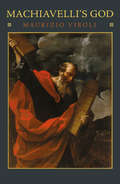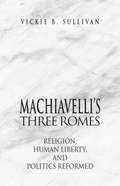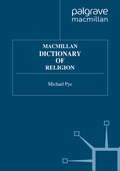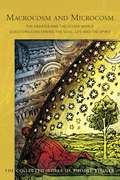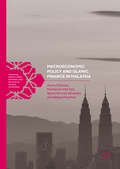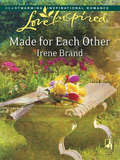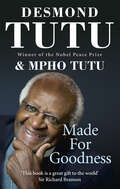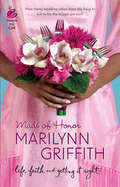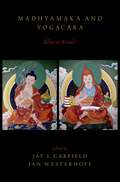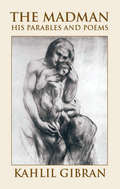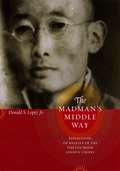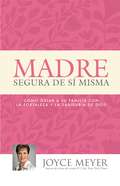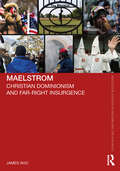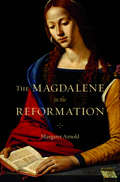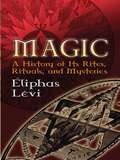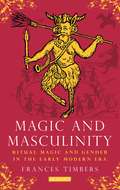- Table View
- List View
Machiavelli's God
by Maurizio Viroli Antony ShugaarTo many readers of The Prince, Machiavelli appears to be deeply un-Christian or even anti-Christian, a cynic who thinks rulers should use religion only to keep their subjects in check. But in Machiavelli's God, Maurizio Viroli, one of the world's leading authorities on Machiavelli, argues that Machiavelli, far from opposing Christianity, thought it was crucial to republican social and political renewal--but that first it needed to be renewed itself. And without understanding this, Viroli contends, it is impossible to comprehend Machiavelli's thought. Viroli places Machiavelli in the context of Florence's republican Christianity, which was founded on the idea that the true Christian is a citizen who serves the common good. In this tradition, God participates in human affairs, supports and rewards those who govern justly, and desires men to make the earthly city similar to the divine one. Building on this tradition, Machiavelli advocated a religion of virtue, and he believed that, without this faith, free republics could not be established, defend themselves against corruption, or survive. Viroli makes a powerful case that Machiavelli, far from being a pagan or atheist, was a prophet of a true religion of liberty, a way of moral and political living that would rediscover and pursue charity and justice. The translation of this work has been funded by SEPS - Segretariato Europeo per le Pubblicazioni Scientifiche.
Machiavelli's God
by Maurizio Viroli Antony ShugaarTo many readers of The Prince, Machiavelli appears to be deeply un-Christian or even anti-Christian, a cynic who thinks rulers should use religion only to keep their subjects in check. But in Machiavelli's God, Maurizio Viroli, one of the world's leading authorities on Machiavelli, argues that Machiavelli, far from opposing Christianity, thought it was crucial to republican social and political renewal--but that first it needed to be renewed itself. And without understanding this, Viroli contends, it is impossible to comprehend Machiavelli's thought. Viroli places Machiavelli in the context of Florence's republican Christianity, which was founded on the idea that the true Christian is a citizen who serves the common good. In this tradition, God participates in human affairs, supports and rewards those who govern justly, and desires men to make the earthly city similar to the divine one. Building on this tradition, Machiavelli advocated a religion of virtue, and he believed that, without this faith, free republics could not be established, defend themselves against corruption, or survive. Viroli makes a powerful case that Machiavelli, far from being a pagan or atheist, was a prophet of a true religion of liberty, a way of moral and political living that would rediscover and pursue charity and justice. The translation of this work has been funded by SEPS - Segretariato Europeo per le Pubblicazioni Scientifiche.
Machiavelli's Three Romes: Religion, Human Liberty, and Politics Reformed
by Vickie B. SullivanMachiavelli's ambiguous treatment of religion has fueled a contentious and long-standing debate among scholars. Whereas some insist that Machiavelli is a Christian, others maintain he is a pagan. Sullivan mediates between these divergent views by arguing that he is neither but that he utilizes elements of both understandings arrayed in a wholly new way. In this illuminating study, Sullivan shows Machiavelli's thought to be a highly original response to what he understood to be the crisis of his times.
Macmillan Dictionary of Religion (Dictionary Series)
by Michael PyeA one-volume dictionary of religion based on concepts drawn partly from the various religious traditions and partly from the historical and reflective study of religion as a modern academic discipline. As a dictionary rather than an encyclopedia, there will be concise explanations on a very large number of special terms rather than lengthy essays on selected subjects. Entries will include definitions of terms from various religious traditions which have now entered into current English usage, as well as a wide variety of semi-technical terms from related fields such as philosophy, sociology and social anthropology.
Macrocosm and Microcosm: The Greater and the Lesser World. Questions Concerning the Soul, Life and the Spirit
by Rudolf SteinerRudolf Steiner shows how deeply and intimately human beings, the microcosm, are related to the macrocosm. But for Steiner the macrocosm is more than just the physical universe. It includes many hidden realms – like the world of Elements and the world of Archetypes – which lie behind outer manifestations such as our physical body. The macrocosm works within us continuously – in the daily alternation between sleeping and waking and in the great cyclical interchange between incarnation on earth and our time between death and rebirth. Steiner discusses the various paths of self-development that lead across the threshold to spiritual dimensions, transforming human soul-forces into organs of higher perception. In future we will even have the capacity to evolve a form of thinking that is higher than the intellect – the thinking of the heart. In this classic series of lectures, now retranslated and featuring a previously-unavailable public address, Rudolf Steiner also discusses: the planets and their connection with our sleeping and waking life; the inner path of the mystic; the ‘greater’ and ‘lesser’ guardians of the threshold; the Egyptian mysteries of Osiris and Isis; initiation in the Northern mysteries; The four spheres of the higher worlds; mirror-images of the macrocosm in man; the strengthening powers of sleep; the symbol of the Rose Cross; reading the Akashic Record; four-dimensional space; the development of future human capacities, and much more. The volume includes an introduction, notes and index.
Macroeconomic Policy and Islamic Finance in Malaysia (Financial Institutions, Reforms, and Policies in Muslim Countries)
by Abbas Mirakhor Syed Othman Alhabshi Azura Othman Norhanim Mat SariThis book offers an alternative framework for macroeconomic policy in Malaysia, derived from the universal principles of social justice espoused in the objectives of the Shariah. It attempts to holistically analyze issues related to public finance, which has been criticized for lack of transparency and justice in wealth distribution. This book explores these criticisms and discusses the principles of Islamic finance that may be applied to macroeconomic policymaking to create a better economy overall. It presents a case for a flat tax system, to make the economy more resilient to shocks, and financing methods that limit interest-rate-based debt contracts and allow greater risk sharing among the market participants on a broad scale. Using both qualitative and quantitative methods, this book models the Malaysian economy based on policies that apply the fundamental Islamic finance principle of risk sharing to demonstrate its benefits in spurring growth, promoting distributive justice, rendering the economy more stable, strengthening the potency of monetary policy, enhancing fiscal governance, and improving financial inclusion. The book will be of interest to students, policymakers, financial institutions, researchers, ministries of finance, central banks, securities commissions, and anyone interested in alternative economic paradigms.
Mad and Divine: Spirit and Psyche in the Modern World
by Sudhir KakarSudhir Kakar, India’s foremost practitioner of psychoanalysis, has focused his career on infusing this preeminently Western discipline with ideas and views from the East. In Mad and Divine, he takes on the separation of the spirit and the body favored by psychoanalysts, cautioning that a single-minded focus on the physical denies a person’s wholeness. Similarly, Kakar argues, to focus on the spirit alone is to hold in contempt the body that makes us human. Mad and Divine looks at the interplay between spirit and psyche and the moments of creativity and transformation that occur when the spirit overcomes desire and narcissism. Kakar examines this relationship in religious rituals and healing traditions— both Eastern and Western—as well as in the lives of some extraordinary men: the mystic and guru Rajneesh, Gandhi, and the Buddhist saint Drukpa Kunley. Enriched with a novelist’s felicity of language and an analyst’s piercing insights and startling interpretations, Mad and Divine is a valuable addition to the literature on the integration of the spirit and psyche in the evolving psychology of the individual.
Made for Each Other (Mills And Boon Love Inspired Ser.)
by Irene BrandSingle mother doesn't seek love Raising a teenager kept widow Aimee Blake too busy for a relationship. Or so she said. Her daughter was trying–with all her rebellious might–to cut the apron strings. So Aimee took some "me time." She attended a singles group and met a handsome counselor as not interested in romance as she was.
Made For Goodness: And why this makes all the difference
by Desmond Tutu Mpho TutuIn Made for Goodness, Archbishop Desmond Tutu explains that, though we sometimes act out of depravity and despair, we do know in our heart of hearts that we are not as we were meant to be, and were created to be so much more. The truth of human goodness can get hidden under the fear that we cannot live up to its demands, or it can get buried under faults or failures, or it can just get forgotten. In this thoughtful and important book, the Archbishop (with his daughter, Mpho Tutu) shows how we can find our way back to goodness by changing our attitudes, by practising forgiveness, and by prayer. Then we will begin to see the goodness and beauty of others... If our view changes, this in turn alters the way we act. And how we act towards each other affects not only ourselves but everything in our world - for the better.
Made Of Honor (Mills And Boon Silhouette Ser.)
by Marilynn GriffithOnce, twice, ten times a bridesmaid! I, Dana Rose, do solemnly swear to say "I won't" the next time someone asks me to be in their wedding party. My weak will has gained me a closet full of unflattering bridesmaids' dresses in various sizes to accommodate my ever-fluctuating waistline.
MADHYAMAKA & YOGACARA C: Allies or Rivals?
by Jay L. Garfield and Jan WesterhoffMadhyamaka and Yogacara are the two principal schools of Mahayana Buddhist philosophy. While Madhyamaka asserts the ultimate emptiness and conventional reality of all phenomena, Yogacara is usually considered to be idealistic. This collection of essays addresses the degree to which these philosophical approaches are consistent or complementary. Indian and Tibetan doxographies often take these two schools to be philosophical rivals. They are grounded in distinct bodies of sutra literature and adopt what appear to be very different positions regarding the analysis of emptiness and the status of mind. Madhyamaka-Yogacara polemics abound in Indian Buddhist literature, and Tibetan doxographies regard them as distinct systems. Nonetheless, scholars have tried to synthesize the two positions for centuries. This volume offers new essays by prominent experts on both these traditions, who address the question of the degree to which these philosophical approaches should be seen as rivals or as allies. In answering the question of whether Madhyamaka and Yogacara can be considered compatible, contributors engage with a broad range of canonical literature, and relate the texts to contemporary philosophical problems.
Madhyamaka and Yogacara: Allies or Rivals?
Madhyamaka and Yogacara are the two principal schools of Mahayana Buddhist philosophy. While Madhyamaka asserts the ultimate emptiness and conventional reality of all phenomena, Yogacara is usually considered to be idealistic. This collection of essays addresses the degree to which these philosophical approaches are consistent or complementary. Indian and Tibetan doxographies often take these two schools to be philosophical rivals. They are grounded in distinct bodies of sutra literature and adopt what appear to be very different positions regarding the analysis of emptiness and the status of mind. Madhyamaka-Yogacara polemics abound in Indian Buddhist literature, and Tibetan doxographies regard them as distinct systems. Nonetheless, scholars have tried to synthesize the two positions for centuries. This volume offers new essays by prominent experts on both these traditions, who address the question of the degree to which these philosophical approaches should be seen as rivals or as allies. In answering the question of whether Madhyamaka and Yogacara can be considered compatible, contributors engage with a broad range of canonical literature, and relate the texts to contemporary philosophical problems.
The Madman: His Parables and Poems
by Kahlil GibranWidely known in America as author of The Prophet, which sold more copies in the 20th century than any other book but the Bible, the great Lebanese-American poet and artist Kahlil Gibran (1883–1931) first became known to Americans in 1918 with the publication of The Madman.Thought-provoking and inspiring, the book is a collection of memorable, life-affirming parables and poems, many of them casting an ironic light on the beliefs, aspirations, and vanities of humankind — and many reminiscent of the work of Tagore and Nietzsche, both of whom were strong influences on Gibran.Among the 35 poems and parables in this volume are "How I Became a Madman," "The Two Hermits," "The Wise Dog," "The Good God and the Evil God," "Night and the Madman," "The Three Ants," "When My Sorrow Was Born," "And When My Joy Was Born," and many more.The book includes several illustrations by the author, whose exquisite drawings are reminiscent of Rodin and the best of Blake. ". . . the greatest of Arab Romantics and father of a 20th-century Romantic tradition whose impact on Arab writers has been at least as strong as that of 19th-century figures such as Wordsworth and Keats on their English-speaking counterparts." — Dr. Suheil Bushrui, Director of the Kahlil Gibran Chair on Values and Peace, University of Maryland
The Madman's Middle Way: Reflections on Reality of the Tibetan Monk Gendun Chopel (Buddhism and Modernity)
by Donald S. Lopez Jr.Gendun Chopel is considered the most important Tibetan intellectual of the twentieth century. His life spanned the two defining moments in modern Tibetan history: the entry into Lhasa by British troops in 1904 and by Chinese troops in 1951. Recognized as an incarnate lama while he was a child, Gendun Chopel excelled in the traditional monastic curriculum and went on to become expert in fields as diverse as philosophy, history, linguistics, geography, and tantric Buddhism. Near the end of his life, before he was persecuted and imprisoned by the government of the young Dalai Lama, he would dictate the Adornment for Nagarjuna’s Thought, a work on Madhyamaka, or “Middle Way,” philosophy. It sparked controversy immediately upon its publication and continues to do so today. The Madman’s Middle Way presents the first English translation of this major Tibetan Buddhist work, accompanied by an essay on Gendun Chopel’s life liberally interspersed with passages from his writings. Donald S. Lopez Jr. also provides a commentary that sheds light on the doctrinal context of the Adornment and summarizes its key arguments. Ultimately, Lopez examines the long-standing debate over whether Gendun Chopel in fact is the author of the Adornment; the heated critical response to the work by Tibetan monks of the Dalai Lama’s sect; and what the Adornment tells us about Tibetan Buddhism’s encounter with modernity. The result is an insightful glimpse into a provocative and enigmatic workthatwill be of great interest to anyone seriously interested in Buddhism or Asian religions.
The Madman's Middle Way: Reflections on Reality of the Tibetan Monk Gendun Chopel (Buddhism and Modernity)
by Donald S. Lopez Jr.Gendun Chopel is considered the most important Tibetan intellectual of the twentieth century. His life spanned the two defining moments in modern Tibetan history: the entry into Lhasa by British troops in 1904 and by Chinese troops in 1951. Recognized as an incarnate lama while he was a child, Gendun Chopel excelled in the traditional monastic curriculum and went on to become expert in fields as diverse as philosophy, history, linguistics, geography, and tantric Buddhism. Near the end of his life, before he was persecuted and imprisoned by the government of the young Dalai Lama, he would dictate the Adornment for Nagarjuna’s Thought, a work on Madhyamaka, or “Middle Way,” philosophy. It sparked controversy immediately upon its publication and continues to do so today. The Madman’s Middle Way presents the first English translation of this major Tibetan Buddhist work, accompanied by an essay on Gendun Chopel’s life liberally interspersed with passages from his writings. Donald S. Lopez Jr. also provides a commentary that sheds light on the doctrinal context of the Adornment and summarizes its key arguments. Ultimately, Lopez examines the long-standing debate over whether Gendun Chopel in fact is the author of the Adornment; the heated critical response to the work by Tibetan monks of the Dalai Lama’s sect; and what the Adornment tells us about Tibetan Buddhism’s encounter with modernity. The result is an insightful glimpse into a provocative and enigmatic workthatwill be of great interest to anyone seriously interested in Buddhism or Asian religions.
The Madman's Middle Way: Reflections on Reality of the Tibetan Monk Gendun Chopel (Buddhism and Modernity)
by Donald S. Lopez Jr.Gendun Chopel is considered the most important Tibetan intellectual of the twentieth century. His life spanned the two defining moments in modern Tibetan history: the entry into Lhasa by British troops in 1904 and by Chinese troops in 1951. Recognized as an incarnate lama while he was a child, Gendun Chopel excelled in the traditional monastic curriculum and went on to become expert in fields as diverse as philosophy, history, linguistics, geography, and tantric Buddhism. Near the end of his life, before he was persecuted and imprisoned by the government of the young Dalai Lama, he would dictate the Adornment for Nagarjuna’s Thought, a work on Madhyamaka, or “Middle Way,” philosophy. It sparked controversy immediately upon its publication and continues to do so today. The Madman’s Middle Way presents the first English translation of this major Tibetan Buddhist work, accompanied by an essay on Gendun Chopel’s life liberally interspersed with passages from his writings. Donald S. Lopez Jr. also provides a commentary that sheds light on the doctrinal context of the Adornment and summarizes its key arguments. Ultimately, Lopez examines the long-standing debate over whether Gendun Chopel in fact is the author of the Adornment; the heated critical response to the work by Tibetan monks of the Dalai Lama’s sect; and what the Adornment tells us about Tibetan Buddhism’s encounter with modernity. The result is an insightful glimpse into a provocative and enigmatic workthatwill be of great interest to anyone seriously interested in Buddhism or Asian religions.
Madre Segura de sí Misma: Como Guiar A Su Familia Con la Fortaleza y la Sabiduria de Dios
by Joyce MeyerEntrenadora, animadora, confidente, cocinera y chofer; la descripcion del trabajo de una madre es tan amplio como el horizonte. Tal vez es por eso que muchas madres luchan con la inseguridad y la incertidumbre, mientras hacen todo lo posible para criar a sus hijos en un mundo exigente y en constante cambio. Si alguna vez ha ido a la cama decepcionada consigo misma, si alguna vez ha sentido como si no diera la talla, o si alguna vez ha deseado que hubiera un manual sobre la maternidad, la autora de exitos de ventas #1 del New York Times, Joyce Meyer, tiene justamente el libro para usted.MADRE DE SI MISMA la animara y sabra que no esta sola; Dios esta con usted y quiere ayudarle con los desafios que enfrenta cada dia. A traves de historias inspiradoras, principios biblicos y las propias lecciones valiosas de la vida de Joyce, no hay duda de que va a descubrir el camino hacia una nueva confianza y alegria en la maternidad. No importa su edad, el tomano de su familia o las condiciones en que se encuentre, MADRE SEGURA DE SI MISMA le ayudara a ser esa madre alegre y confiada que Dios creo para que sea!
Madurai Meenatchi Ammai Pillai Tamizh
by KumarakurupararPillai Tamil or the "Tamil of Childhood" is one of the ninety-six forms of minor poetical compositions.In this literary compositon, Kumaraguruparar expresses his deep love for Tamil, as in his other works also, with apt descriptions and illustrations while delineating the characteristics of Goddess Meenakshi.
Maelstrom: Christian Dominionism and Far-Right Insurgence (Routledge Studies in Fascism and the Far Right)
by James AhoMaelstrom: Christian Dominionism and Far-Right Insurgence illuminates the latest outbreak of right-wing extremism in America. This book reviews the cyclical nature of right-wing resurgences in American history, dismisses the appropriateness of the word “fascism” to explain them, and then describes in depth the goal of “reconstructing” American institutions on the basis of biblical principles. It critiques the popular view that far-right politics is carried by stupid, socially isolated, nuts. To this end, it discusses the logicality of the “big lie” and examines in detail how people are recruited into the far-right, by entertaining the theories of authoritarianism and resource mobilization. Finally, it characterizes how the ends-oriented rationality of far-right activists differs from the mini-max criterion of rationality utilized by the ordinary person. This can motivate them to be violent and can frustrate efforts by the government to control them.
Maelstrom: Christian Dominionism and Far-Right Insurgence (Routledge Studies in Fascism and the Far Right)
by James AhoMaelstrom: Christian Dominionism and Far-Right Insurgence illuminates the latest outbreak of right-wing extremism in America. This book reviews the cyclical nature of right-wing resurgences in American history, dismisses the appropriateness of the word “fascism” to explain them, and then describes in depth the goal of “reconstructing” American institutions on the basis of biblical principles. It critiques the popular view that far-right politics is carried by stupid, socially isolated, nuts. To this end, it discusses the logicality of the “big lie” and examines in detail how people are recruited into the far-right, by entertaining the theories of authoritarianism and resource mobilization. Finally, it characterizes how the ends-oriented rationality of far-right activists differs from the mini-max criterion of rationality utilized by the ordinary person. This can motivate them to be violent and can frustrate efforts by the government to control them.
The Magdalene in the Reformation
by Margaret ArnoldProstitute, apostle, evangelist—the conversion of Mary Magdalene from sinner to saint is one of the Christianity’s most compelling stories. Less appreciated is the critical role the Magdalene played in remaking modern Christianity. Margaret Arnold shows that the Magdalene inspired devotees eager to find new ways to relate to God and the Church.
Maggie's Miracle: A Novel
by Karen KingsburyMegan Wright spent one unforgettable summer week with a boy when they were both teens. And despite a lifetime of heartache and bad choices, she has never let go of his magical definition of love, even if she has trouble believing in it. After college Megan settled for a relationship of convenience. Now she's a high powered attorney and, after the death of her husband two years ago, has been looking for help with her lonely young son. Across town, Casey Cummins is still dealing with the tragic loss of his wife. His search for meaning and hope leads him to contact the Manhattan Children's Organization, who connects him with a fatherless child. Life suddenly takes a series of unusual twists, and soon Megan will learn that the teenage boy from all those years ago actually kept his promise, and the miracle she prayed for as a girl is only a breath away.
Magic: A History of Its Rites, Rituals, and Mysteries
by A. E. Waite Éliphas Lévi"The most arresting, entertaining, and brilliant of all studies on the subject." — Arthur Edward WaiteA great work of literature as well as a pioneering classic of occultism, this voluminous historical survey traces the roots and manifestations of magic through the ages as a secret tradition persisting from remote times. Author Éliphas Lévi, pseudonym of Alphonse Louis Constant (1810-75), was a leader of the French occult revival, a spiritual teacher and magus who is today considered by some to be a founding father of the New Age movement. One of his most stunning (and original) revelations connects the Kabbalah with the Tarot, thus helping to inspire the ongoing fascination with the symbols of both, and their correspondences with each other. In this 1860 work, Lévi's discussions include topics that continue to intrigue modern readers, subjects as seemingly disparate as the mathematical magic of Pythagoras, magical monuments, magic and Christianity, the devil, the Knights Templar, alchemy, the illuminati, hallucinations, and many others that are equally alluring.The first part of the book explains the principles underlying magical operations, while the second part addresses the actual ritual and practice of transcendent magic. An essential resource for the library of anyone interested in mysticism and the occult sciences, this influential work appears here in its first English translation (from the original French) by the distinguished scholar and co-creator of the Rider-Waite Tarot deck, A. E. Waite.
Magic and Divination in the Old Testament
by Solomon NigosianHumans, since time immemorial, have tried to discover and influence the will of spirits and deities that they believed to be in charge of their lives. As a result, all cultures have produced certain special individuals thought to be closely in touch with the powers of the supernatural world. Was this true of ancient Israel? If so, who were the occult experts and what techniques were used by them? This study explores the many practices and rituals associated with magic and divination among the ancient Israelites as documented in the Old Testament. Seeking omens and consulting seers and diviners were widely practiced, though in the biblical text such activities are roundly condemned. Solomon Nigosian's scholarly work is written in language that makes it absorbing reading for both the biblical scholar and the layperson.
Magic and Masculinity: Ritual Magic and Gender in the Early Modern Era (International Library Of Historical Studies)
by Frances TimbersIn early modern England, the practice of ritual or ceremonial magic – the attempted communication with angels and demons – both reinforced and subverted existing concepts of gender. The majority of male magicians acted from a position of control and command commensurate with their social position in a patriarchal society; other men, however, used the notion of magic to subvert gender ideals while still aiming to attain hegemony. Whilst women who claimed to perform magic were usually more submissive in their attempted dealings with the spirit world, some female practitioners employed magic to undermine the patriarchal culture and further their own agenda. Frances Timbers studies the practice of ritual magic in the sixteenth and seventeenth centuries focusing especially on gender and sexual perspectives. Using the examples of well-known individuals who set themselves up as magicians (including John Dee, Simon Forman and William Lilly), as well as unpublished diaries and journals, literature and legal records, this book provides a unique analysis of early modern ceremonial magic from a gender perspective.
